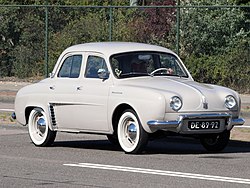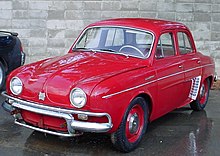Renault Dauphine
| Renault | |
|---|---|
|
Renault Dauphine (1956-1968)
|
|
| Dauphine | |
| Production period: | 1956-1968 |
| Class : | Lower middle class |
| Body versions : | limousine |
| Engines: |
Petrol engines : 0.85 liters (19.5–36 kW) |
| Length: | 3937 mm |
| Width: | 1524 mm |
| Height: | 1441 mm |
| Wheelbase : | 2267 mm |
| Empty weight : | 650 kg |
| Previous model | Renault 4CV |
| successor | Renault 8 |
The Renault Dauphine is a passenger car model built by the French manufacturer Renault from 1956 to 1968 . The vehicle with a water-cooled four - cylinder in - line engine and rear-wheel drive (i.e. rear-engine and rear-wheel drive) had a typical pontoon body . Like its predecessor, the 4CV , the Dauphine was only available as a four-door sedan .
The name Dauphine means "heir to the throne" and was aimed at the sales success of the Renault 4CV in Europe. The Dauphine was especially popular in Germany, where the two-door VW Beetle and (from 1962) Opel Kadett remained in the top ranks.
concept
Renault wanted to create a larger car with as many parts of the 4 CV model as possible in order to reduce the gap in the model range between 4 CV and Frégate somewhat. As a result, the wheels were suspended from double wishbones at the front and a pendulum axle at the rear. The vehicle should reach a top speed of around 115 to 120 km / h and consume 6 to 7 liters of gasoline per 100 kilometers. In fact, the travel consumption was 7.5 l / 100 km, making the Dauphine one of the most economical cars in its class by international standards. The first test cars still had the 4-CV engine with 747 cm³, but were already more powerful. Then the displacement was increased to 845 cm³. An automatic choke was also new, but the 4 CV also got it. A special feature was the accommodation of the spare wheel, it was under the trunk and could be taken out of its compartment after opening a flap under the front bumper. A sunroof and the automatic Ferlec clutch known from the 4 CV were available for an additional charge . From 1963 a version with an electromagnetic Jaeger clutch and automatic gearshift was available. The Dauphine was produced at Renault's Flins plant.
Dauphine Gordini
From 1958 the Dauphine Gordini model was built, which had an output increased from 26.5 to 33, later 36 hp and reached a top speed of 125 km / h instead of 114 km / h with the usual engine. From the summer of 1965 only the Gordini version was built.
Dauphine 1093
In 1959, a model called the R1093 or Rallye-Dauphine was developed for motor racing and took part in various car races, such as the Monte Carlo Rally . The engine output of this model was increased to 49 hp, the brake drums were provided with cooling fins and a 5-speed gearbox was installed. The 1093 reached 140 km / h.
Ondine
A luxury version was sold from 1960 to 1962 as Ondine (in German "Nixe").
Aérostable
In the summer of 1958, the Dauphine was given a special suspension called Aérostable. It had very soft steel springs with a flexibility of 72 mm at the front and 41 mm at the rear per 100 kg of load. To prevent the suspension from bottoming out, there was an auxiliary suspension. It consisted of rubber springs at the front and air-filled rubber cushions with atmospheric pressure at the back. When the Dauphine got the rear axle of the successor R 8 in the summer of 1963, the Aérostable was discontinued. With this rear axle, the Dauphine also received four disc brakes, which was unusual for a car of this class.
US export
With the Dauphine Renault tried to conquer the US market, but it failed. In contrast to Volkswagen, the dealers were not carefully selected and a functioning spare parts supply was not established. As a result, new vehicles were misused as spare parts reservoirs and dealers were unable to meet their specifications. 1959 peaked with over 100,000 sales, then the number fell sharply. The imports were adjusted too late. The vehicles were stored near the port and there was damage to the floor, in particular corrosion damage from the nearby seawater. After all, the vehicles could only be sold at significant discounts.
In the same year Henney Motor Company ordered 100 Dauphines without a drive unit in order to equip them with an electric drive and to sell them as Henney Kilowatts .
Alfa Romeo Dauphine
Alfa Romeo built the Dauphine under license from 1960 to 1966 at the Portello plant near Milan. They didn't have a small car on offer and wanted to get a full range. This happened mainly with regard to the main competitor Fiat. The Dauphine from Italian production had some local parts and, above all, no aerostable suspension because it was designed too much for comfort and therefore did not fit the other Alfa models. That is why Alfa Romeo rejected Renault's offer to also produce the R 4 under license.
literature
- Arthur Westrup (Ed.), Klaus Hansen (Red.): My experiences with the Renault Dauphine. (= My experiences with the ... specialist engineers and drivers report. Volume 16) Delius, Klasing & Co., Bielefeld 1959.
- Werner Oswald: Renault Dauphine, Renault Floride, Renault 4 CV. (= The Motor Test. Volume 15) Motor-Presse-Verlag, Stuttgart 1960.
- Renault Dauphine - an 850 cc small car. In: Motor Vehicle Technology 6/1956, pp. 227–228.
Web links
Individual evidence
- ↑ Use value of small cars. In: Motor Vehicle Technology 5/1962, pp. 203–205.
- ↑ Automatic switching for small cars . In: Motor Vehicle Technology 5/1963, pp. 183-184.
- ↑ a b c Albert Rupprecht: French passenger cars since 1945 , e-book 2014, ISBN 978-3-00-032545-8 , chapter Renault Dauphine
- ↑ Dauphine modified by Gordini. In: Automobiltechnik 4/1958, p. 158
- ^ A b Ulrich Bethscheider-Kieser: Renault. Under the sign of the rhombus. Motorbuchverlag, Stuttgart 1995, ISBN 3-613-01658-3 , p. 244.
- ↑ http://www.autogate.de/renault-dauphine-erverbindungen-weltenbummlerin-2108.html
- ^ Albert Rupprecht: French passenger cars since 1945 , e-book 2014, ISBN 978-3-00-032545-8 , chapter Introduction to Renault






